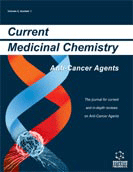Abstract
Cancer chemotherapy is associated with severe side effects which may be reduced by selective liberation, at the tumour site, of a cytotoxic agent from a non-toxic prodrug. Several strategies are used to achieve the required selective activation : with enzymes which are present in higher concentration in, or close, to the tumour (β-glucuronidase, plasmin), with enzymes covalently linked to a macromolecular carrier able to recognize antigen positive cancer cells (ADEPT : Antibody Directed Enzyme Prodrug Therapy) or with reductive processes which are favoured in an hypoxic environment. Most of the prodrugs include a linker (or spacer) between the trigger and the drug (or effector). The design of such linkers is crucial in order to achieve a fast drug liberation under physiological conditions. The linker groups may be classified in two categories based on elimination or cyclization processes. The advantages and the limitations of each strategy are discussed.
Keywords: Anticancer Prodrugs, Phenol Based Linkers, hydroxylamine, glutamine antimetabolite, Cephalosporin-Based, deacetylvinblastine (DAVLB), 4-hydroxyanisole
 20
20

















